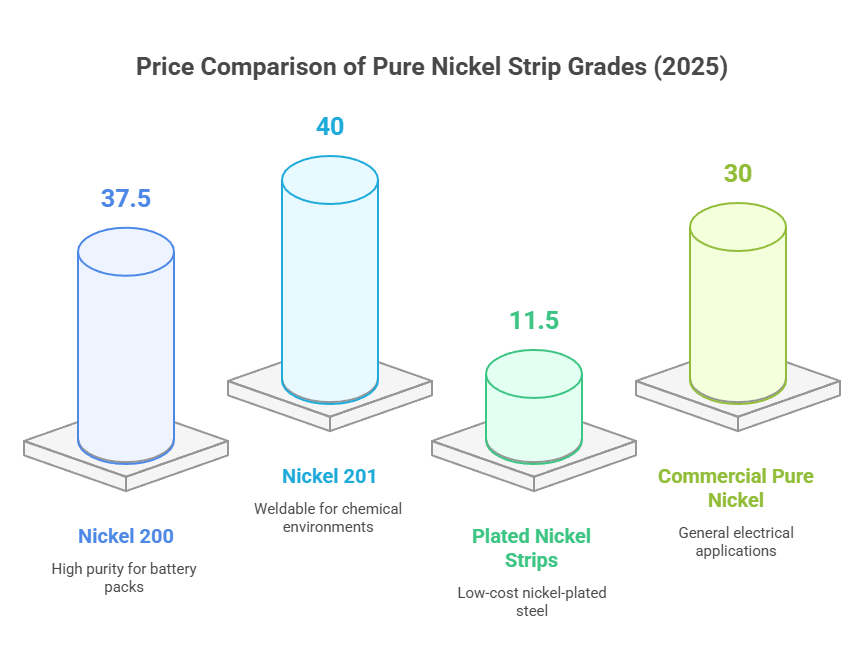Pure nickel strips are widely used in the manufacturing of lithium-ion batteries, electrical connectors, and chemical equipment due to their excellent conductivity, corrosion resistance, and weldability. This article examines the pricing structure of pure nickel strips, the factors that influence their cost, different grades, and the global market landscape in 2025.

What Are Pure Nickel Strips?
Pure nickel strips are thin, flat pieces made primarily of nickel, usually with a purity level of 99.6% or higher. They are commonly used to connect battery cells, especially in electric vehicles (EVs), power tools, and energy storage systems, due to their high current-carrying capacity and corrosion resistance.
Common Grades of Pure Nickel Strips and Price Range
The price of pure nickel strips varies significantly depending on the grade and form. The following table outlines typical grades and price ranges in 2025:
| Grade | Nickel Purity | Application | Price (USD/kg) |
|---|---|---|---|
| Nickel 200 | ≥99.6% | Battery packs, EV connectors | $30 – $45 |
| Nickel 201 | ≥99.6% | Chemical environments, weldable components | $32 – $48 |
| Plated Nickel Strips | ~98% (Nickel-plated steel) | Low-cost battery packs | $8 – $15 |
| Commercial Pure Nickel | ≥99.0% | General electrical uses | $25 – $35 |
Factors Affecting Pure Nickel Strip Prices
Several dynamic factors contribute to the price volatility of pure nickel strips:
| Factor | Effect on Price |
|---|---|
| Nickel Raw Material Prices | Changes in LME nickel spot prices directly impact strip cost. |
| Purity and Grade | Higher purity strips require more refined processing and thus cost more. |
| Thickness and Width | Thinner or custom-sized strips can increase processing costs. |
| Order Volume | Bulk orders often reduce per-kg cost due to economies of scale. |
| Market Demand | High demand from EVs and battery storage raises global strip prices. |
| Shipping and Tariffs | Import duties and freight rates can add 10–20% to strip prices. |
Pure Nickel Strip vs. Nickel-Plated Steel Strip
Many buyers confuse pure nickel strips with nickel-plated steel strips, which are significantly cheaper but less efficient in battery applications. Here’s a direct comparison:
| Property | Pure Nickel Strip | Nickel-Plated Steel Strip |
|---|---|---|
| Conductivity | Excellent | Moderate to Low |
| Corrosion Resistance | High | Low (core is steel) |
| Price | $30–$45/kg | $8–$15/kg |
| Battery Safety | High | Low (can overheat) |
2024–2025 Price Trends for Pure Nickel Strips
During 2024 and into mid-2025, the price of pure nickel strips has risen steadily. This increase is driven by battery-grade nickel demand and nickel supply tightening due to export restrictions and high processing costs.
| Month | Avg. Price Nickel 200 Strip (USD/kg) |
|---|---|
| January 2024 | $31.20 |
| April 2024 | $34.10 |
| July 2024 | $35.80 |
| October 2024 (forecast) | $37.50 |
| January 2025 (forecast) | $39.00 |
Best Practices When Buying Nickel Strips
1. Know Your Grade: Always confirm with suppliers whether strips are pure nickel or nickel-plated steel.
2. Request Third-Party Tests: Many low-cost vendors sell plated steel as pure nickel—ask for lab analysis if unsure.
3. Evaluate Supplier Reliability: Choose vendors with proven track records in battery-grade nickel products.
4. Consider Domestic vs. International: While China often offers lower prices, shipping and customs delays may offset savings.
Related Questions
How much does pure nickel strip cost?
The cost of pure nickel strip ranges from $30 to $48 per kilogram depending on grade, thickness, and quantity.
Can I use nickel-plated steel strips in lithium batteries?
It’s not recommended—nickel-plated steel has lower conductivity and corrosion resistance, which can lead to safety issues and poor performance.
What is the difference between Nickel 200 and Nickel 201 strips?
Nickel 200 has a slightly higher carbon content than Nickel 201, making it stronger but slightly less weldable; both are suitable for battery connections.



